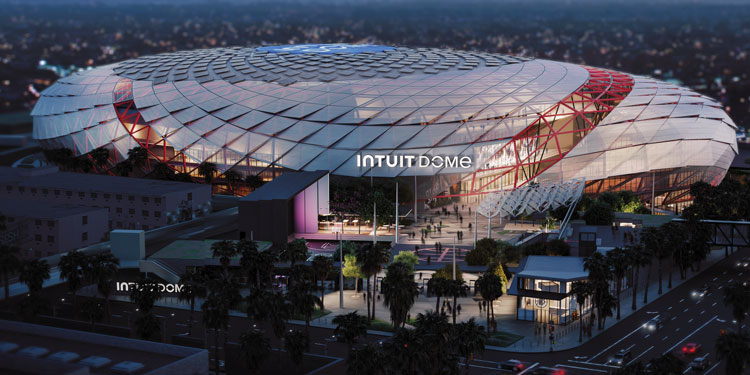
July 26, 2024
2024 Computational Design Award
INTUIT Dome Arena, Inglewood, CA
AECOM
“A textbook example of how computational design can push the boundaries of architecture, the jury was particularly impressed with the exceptional innovation, creativity, and technical complexity showcased in the work. The seamless integration of generative design and environmental simulations demonstrated a clear and sophisticated approach to form-finding solutions. The project proved that this approach to problem-solving can have measurable impacts on both the environment and functionality. By leveraging advanced techniques, it shows how computational design can address environmental concerns and enhance the usability of architectural spaces.”
~ co.de.D 2024 Jury
PROJECT STORY
The groundbreaking INTUIT Dome arena is inspired by Clippers owner Steve Ballmer’s vision to create an exceptional fan experience focused on user comfort. The 18,000-seat sports and entertainment campus includes an 85,000-sf practice facility, 71,000-sf office space and 25,000-sf for sports medicine, retail, and concert stage. The $2 Billion development located in Inglewood California features a translucent oval -shaped dome, the world’s largest video board, wired power for every seat, frictionless concessions, and quick restroom access. Sustainability is prioritized with carbon-free operation, natural ventilation, and solar power. The Intuit Dome redefines sports venues by emphasizing simplicity, convenience, and fan-centric design through computational design innovation.
INNOVATION + CREATIVITY
Architectural Geometry and Form:
• Diagrid Geometry: The INTUIT Dome’s diagrid steel frame geometry optimizes structural efficiency while creating an aesthetically captivating form. Computational design processes generated and analyzed these patterns, ensuring integration of strength, visual appeal, and team documentation & coordination.
• Adaptive Building Skin: The visually striking facade comprises diamond -shaped, PTFE mesh panels that serve multiple functions, from view control, solar shading, and natural ventilation. Computational scripting tools enabled designers to iteratively refine panel geometries, sizes, and orientations, while panel optimization reduced complexity & count (from 6,000 to 1,200 panels) and construction cost.
PERFORMANCE + EFFECTIVENESS
Sustainability and Energy Efficiency:
• LEED Platinum Aspiration: Computational simulations guided decisions for energy-efficient systems. The INTUIT Dome aims for LEED Platinum certification with optimized building orientation, glazing, passive ventilation, and insulation to minimize energy consumption.
• Solar-Optimized Shell: Computational models analyzed façade solar exposure to balance daylight and solar heat gain through the translucent PTFE and ETFE dome, creating a naturally ventilated outdoor public concourse while reducing reliance on artificial lighting and HVAC systems.
• Carbon-Free Operation: Energy & Carbon analysis factored solar power, battery storage, and electric systems. Computational energy & carbon analysis tools assessed energy demand, storage capacity and grid interactions. An estimated 260 solar panels provide 13 megawatts of batter y energy—the most of any arena on Earth, enabling the arena to operate off the LA power grid for up to seven hours. The result was a 100% carbon-free operation from day one.
FUNCTIONALITY + USABILITY
Fan Experience and Sightlines:
• The Wall: A vertical grandstand zone of 51 uninterrupted rows of 4,500 seats exclusively for Clippers fans, creates a home court advantage, with dominant proximity and views over the visiting team bench, floor, or stage. Seat scripting optimized sightlines for every seat, enhancing the Fan Experience.
• Bowl Design: Computational simulations determined optimal seat placement. Row 20 is 45 feet closer to the action—almost half-court—compared to the downtown arena. Fans across all sections enjoy unparalleled views.
• Frictionless Technology and Fan Engagement: Computer models informed the placement of the largest-ever double-sided halo display within the arena. This high-tech scoreboard delivers replays, video, and advanced stats without impacting sight lines.
In summary, computational design strategies were integral to achieving the Intuit Dome’s performance goals, energy efficiency, and distinctive façade design – to elevate the fan experience.
